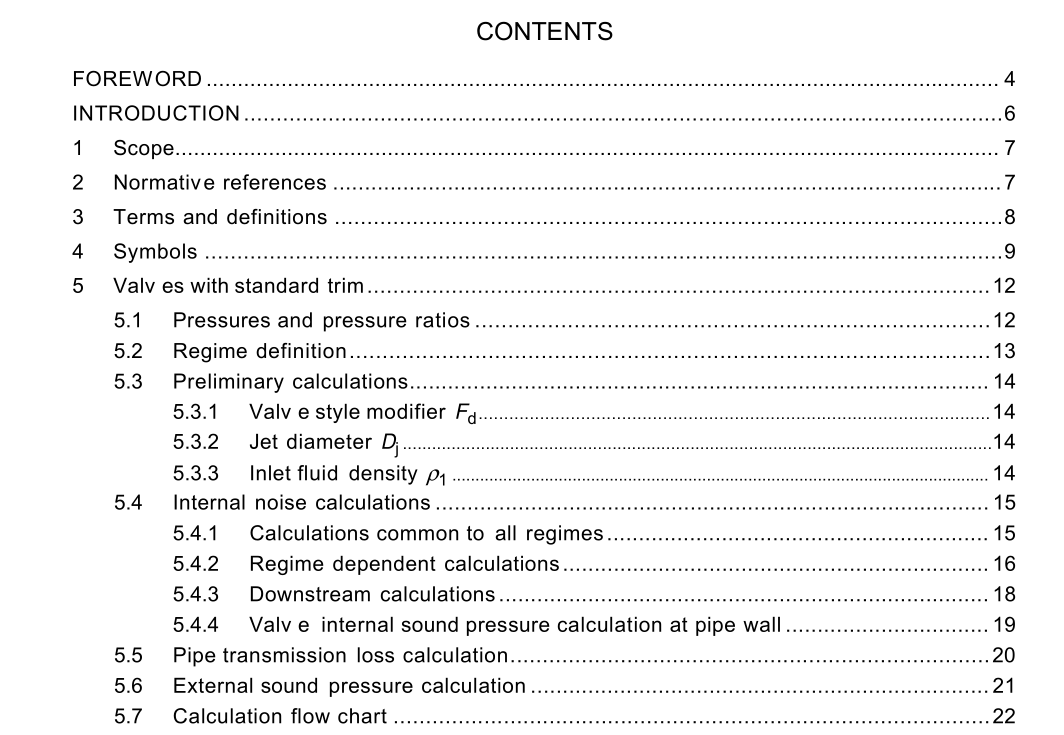IEC 60534-8-3 pdf download,Industrial-process control valves – Part 8-3: Noise considerations – Control valve aerodynamic noise prediction method
1 Scope
This part of IEC 60534 establishes a theoretical method to predict the external sound- pressure lev el generated in a control v alv e and within adjacent pipe expanders by the flow of compressible fluids. This method considers only single-phase dry gases and vapours and is based on the perfect gas laws. This standard addresses only the noise generated by aerodynamic processes in v alv es and in the connected piping. It does not consider any noise generated by reflections from external surfaces or internally by pipe fittings, mechanical v ibrations, unstable flow patterns and other unpredictable behav iour. It is assumed that the downstream piping is straight for a length of at least 2 m from the point where the noise measurement is made. This method is valid only f or steel and steel alloy pipes (see Equations (21) and (23) in 5.5). The method is applicable to the following single-stage v alv es: globe (straight pattern and angle pattern), butterfly, rotary plug (eccentric, spherical), ball, and v alv es with cage trims. Specifically excluded are the f ull bore ball v alv es where the product F p C exceeds 50 % of the rated f low coefficient. For limitations on special low noise trims not cov ered by this standard, see Clause 8. W hen the Mach number in the v alv e outlet exceeds 0,3 f or standard trim or 0,2 for low noise trim, the procedure in Clause 7 is used
3 Terms and definitions
For the purposes of this document, all of the terms and definitions giv en in the IEC 60534 series and the f ollowing apply: 3.1 acoustical efficiency η ratio of the stream power conv erted into sound power propagating downstream to the stream power of the mass flow 3.2 external coincidence frequency f g frequency at which the external acoustic wav espeed is equal to the bending wav espeed in a plate of equal thickness to the pipe wall 3.3 internal coincidence frequency f o lowest frequency at which the internal acoustic and structural axial wav e numbers are equal for a giv en circumferential mode, thus resulting in the minimum transmission loss 3.4 fluted vane butterfly valve butterfly v alv e which has flutes (groov es) on the face(s) of the disk. These flutes are intended to shape the f low stream without altering the seating line or seating surface 3.5 independent flow passage flow passage where the exiting f low is not affected by the exiting f low from adjacent f low passages 3.6 peak frequency f p frequency at which the internal sound pressure is maximum 3.7 valve style modifier F d ratio of the hydraulic diameter of a single flow passage to the diameter of a circular orifice, the area of which is equiv alent to the sum of areas of all identical flow passages at a given travel
5.2 Regime definition A control v alv e controls flow by conv erting potential (pressure) energy into turbulence. Noise in a control v alv e results from the conv ersion of a small portion of this energy into sound. Most of the energy is conv erted into heat. The different regimes of noise generation are the result of differing sonic phenomena or reactions between molecules in the gas and the sonic shock cells. In regime I, the flow is subsonic and the gas is partially recompressed, thus the inv olv ement of the factor F L . Noise generation in this regime is predominantly dipole. In regime II, sonic flow exists with interaction between shock cells and with turbulent choked flow mixing. Recompression decreases as the limit of regime II is approached. In regime III, no isentropic recompression exists. The flow is supersonic, and the turbulent flow-shear mechanism dominates. In regime IV, the shock cell structure diminishes as a Mach disk is formed. The dominant mechanism is shock cell-turbulent flow interaction. In regime V, there is constant acoustical efficiency; a further decrease in p 2 will result in no increase in noise.
IEC 60534-8-3 pdf download
